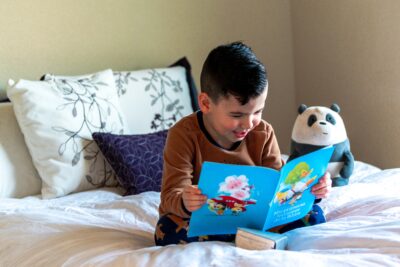4 Reading Tips for Parents and Caregivers
Try these teacher-created reading tips to help grow young readers
Want your elementary school-aged child to become a better reader? We’ve been thinking about that, too, and compiled this list of reading tips!
The teachers of The Community Classroom have put their heads together and created a list of reading strategies for caregivers when it comes to supporting readers at home. Here is a list of 4 reading tips that are research-based classroom practices that anyone can apply to support the growth of a young learner.
Reading Tip #1: Access
Access to reading material is a reading tip and practice that is backed up by numerous literacy studies. And we don’t mean just books. But having a print-rich environment where a child can pick up a newspaper (yes, they still print them in some places!), magazine, recipe, catalog, manual…really anything helps them grow as a reader as they explore different kinds of text. Side note: It can also keep us from getting overly bored as parents and caregivers (we all know that this can happen when reading the same Pete the Cat book for the 400th time). Need help with ideas? Check out this list created by Scholastic.
Reading Tip #2: Choice
Offering choice to kids gives them ownership, which will help keep your child interested and motivated. This reading tip can be a hard pill to swallow as parents and caregivers when our precious junior wants to read a graphic novel instead of our own childhood favorite we gifted them and still sits on their nightstand (so sorry, The Secret Garden). But trust us—choice is the key to turning children into readers. Want your child to really giggle? Ask them to read a bit of the text they chose to you (and hold on to that moment and enjoy it).
Reading Tip #3: Rereading
We’ve all been there. Junior wants to reread Wheels on the Bus for the 399830234 time and we don’t think we can stand it as a parent. Not one. More Time.
But here’s something to think about—our children need to reread books. Again and again. This reading tip is tough but golden. Even if we have read Goodnight Moon so many times we can recite it, dig in and read it one more time! Rereading books helps build reading fluency—the speed, accuracy, and expression—which helps deepen their understanding and comprehension (read more on fluency here). Readers get something new out of a book every time they read it—they dig in another layer, make more connections, and get more out of the book. So the next time you see Junior with the Lunch Lady and the Cyborg Substitute in his hands, even if it’s the 439th time he’s read it, give him a high five for engaging in a strategy that will help him grow as a reader. Then pat yourself on the back. Good job, caregiver!
Reading Tip #4: Wordplay and word games
This reading tip is fun and purposeful! Anytime we are playing a word game, we are helping our children learn to be better decoders and readers. Decoding is how kids attack words they don’t know, which can involve knowing letter-sound relationships, understanding letter patterns, and how to pronounce words (read more on decoding in this article from Understood.org). It’s a crucial skill for reading.
Below are a couple of examples to get your wheels turning (and even some games you might have on hand).
- I spy (except you aren’t “spying” something with a certain color, you are “spying” something that begins with a letter or a blend of letters.
- A rhyming game. For example, “I’m an animal and I rhyme with mat. What animal could I be?”
- Or maybe you have magnetic letters on hand? Challenge your child to make words! You can leave it as an open task or give them specific instructions (all the words you can think of that end in “th.”)
- Letter mixup! Write a word on a strip of paper. Cut out each letter. Have your child piece the word back together again.
- Also, Scrabble and Bananagrams are great games you might already have on hand.
Find more examples of wordplay and word games in this article from We Are Teachers and this one from Scholastic.
And now a teaser! We’ll be sharing our favorite games for building decoding skills in next week’s blog post.
Looking for more ideas and tips? Check out:
- This blogpost on math games to try at home
- This article on signs your child might need extra reading help
- This article on signs your child might need some extra math help
- And this piece on taking math outside now that the weather is nice!
If you’d like our certified teachers to work with your child to boost their skills, confidence, and joy as a reader, please contact us.
Photo of a girl reading on the beach by Jyotirmoy Gupta on Unsplash
Photo of the boy reading on a bed by Gabriel Tovar on Unsplash
Photo of a girl looking at books on a bookshelf by Suad Kamardeen on Unsplash
Photo of a girl reading a book by Annie Spratt on Unsplash
Photo of Scrabble letters spelling “keep it fun” by Brett Jordan on Unsplash






0 Comments